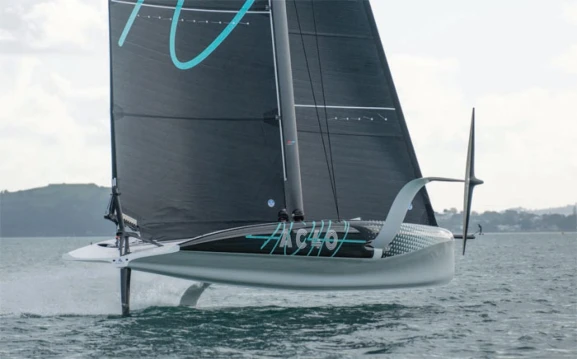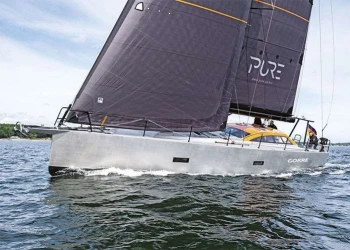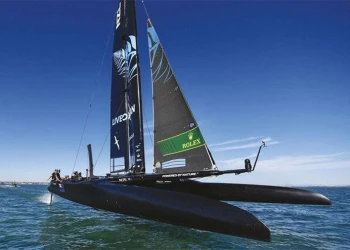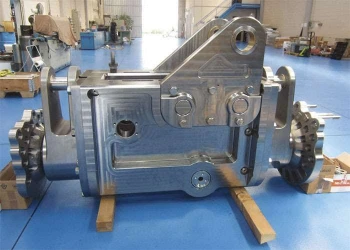
Fine control of the mainsheet is essential not just for achieving maximum sailpower on a foiling AC boat, it’s also crucial for roll stability. The mainsheet system is working constantly, always near maximum load.
Harken to redevelop its hardware for a whole new performance level
Most of us take traveller cars and tracks for granted but the extreme sail trimming and roll stability requirements of AC75s and AC40s required Harken to redevelop its hardware for a whole new performance level
Balancing a monohull with no keel on a pair of foils that are offset from the yacht’s centreline has been one of the biggest challenges for highperformance yacht design in recent years. Understandably, in achieving this the foils themselves have attracted plenty of attention, particularly among commentators and spectators at the last America’s Cup in Auckland 2020-21.
However, as we are now starting to understand there are far more elements involved in keeping a highspeed show on the road, not least the way in which both the power that’s generated by the mainsail and the roll stability control of the boat are achieved through the fine control of the mainsheet. Here, hardware experts Harken have been in the front line of development in an area of deck gear that many of us would normally take for granted: the traveller track and car. And while Harken was also involved in other key areas such as the winches and the self-tacking system for the jib, the mainsheet system was the most challenging area.
‘We worked closely with Emirates Team New Zealand with the development of the AC40,’ explains Mark Wiss, director of global grand prix and custom yacht sales at Harken.
‘This collaboration has led to developments in the deck gear elsewhere too as the new style of sailing develops. For example the bowsprit is gone and now there’s a self-tacking jib so the basic configuration has changed a fair bit since the first concept for the AC75 was announced.’
The evolution of any new class will always throw up new ideas, layouts and working practices and the deck hardware will adapt to the change. But the AC40 has marked a very different approach. In addition to creating the next generation of America’s Cup machines, the longerterm success of the AC40 also depends on being able to make monohull flight easier to achieve in the broader grand prix racing world outside the Cup circle. And for this to happen the speed and accuracy of the mainsheet system is crucial.
As the story of the last America’s Cup unfolded it became clear that the double-skinned mainsail configuration was far more complex than it looked at first sight. Yes, the outline of the AC75 sail plan marked a return from solid wings, one that was more in keeping with conventional looking racing sails, but from there on, and under closer inspection, it has become apparent that the new America’s Cup mainsail configuration is both sophisticated and highly loaded.
Be it the AC75 or the smaller one-design AC40, boatspeed in the region of 40kts produces very high apparent wind and narrow apparent wind angles, two factors that contribute to extremely high loads in the clew of the mainsail. And it is this that is the starting point for the new area of development.
‘In principle the tracks and cars that we’ve supplied for the AC40s are quite a similar setup to what we did on the AC50 catamarans in Bermuda,’ Wiss continues. ‘The self-tacking 32mm CRX that is used on the AC40 is a three-car system, which is an updated version of that used on the AC50 catamaran. The self-tacking system eliminates the need for a trimmer on each side as there is no longer a need to release and pull the jib sheets. Instead, the jib sheeting is all down to a single sheet that is managed by a hydraulic cylinder. The sheet is set up like a Soling where the sheet goes between the clew and the cars before going forward to the bow and then back to a hydraulic cylinder.
‘Because the track is curved there are three cars that are connected together because they need to go through the bend. If you have a long car, it doesn't travel around the curved surface. The mainsheet traveller system also runs on a curved track but it is far more complicated and was a specific area of development at Harken. We call it Flight Control.’
One of several key reasons that set the AC75 and AC40 mainsheet tracks apart from others is the need to pump the mainsail to help get the boat up and onto its foils in light airs. Think windsurfing or Moth sailing and you’ll be creating the right mental image. Being first onto the foils and/or last to come off them presents a huge advantage so the incentive is there. But on a Cup boat the loads are extremely high.
‘In light weather, to start the flight and then once they're flying you'll see that the traveller system is moving a lot. The cars that are moving at high speed and more importantly at high frequency. So unlike a keelboat where you pull the car up every once in a while in the lulls and drop it down in the gusts, here the car is moving all the time. It never stops.
‘It's being operated hydraulically so the grinders or the cyclers are now having to push oil. Every time the car moves it is using oil pressure that they are creating. So the real challenge was developing the bearings in the cars and the track to be very efficient, especially at high speed and high frequency, which is something that you don't usually do in sailing. One of the starting points for us was to optimise our traditional roller bearing cars to work with the new loads and frequency that were required for this flight control concept.
‘The track itself is a new shape plus it pivots. And while a bend in the vertical plane like a smile isn’t new, now it's got to pivot fore and aft.’ But even then that’s not the end of the issues around movement that have to be catered for. ‘The mainsheet is a hydraulic cylinder that comes straight to the car,’ Wiss continues. ‘And this cylinder is positioned in between the two mainsail skins which in turn have another Flight Control pivoting track that's sewn on to the clew of the sail.
‘When you tack or gybe the boat the two mainsails have to keep their correct depth by sliding past each other. These have to move and at the same time the traveller car is also moving constantly. Plus, it’s always at full working load. Unlike a normal keelboat where the load comes off, the car moves and the load comes back on again, aboard an AC75 or AC40 the sheet barely gets eased.
‘Putting all of these combinations together meant that we had to work on updating and revising how we design the cars and the track to work at high speed, high frequency and always at working load.
‘To evaluate this we set up various tests in HarkenLab where we investigated different bearing materials to make sure that they were efficient. After that and perhaps most importantly we put the designs through an endurance test where the cars travelled a total of 14km on the track to simulate 10 days of sailing.
‘Once again this is way beyond what you’d expect for a normal racing keelboat.’ Interestingly, the company ruled out ceramic coatings for this application despite their popularity in other areas, especially winch drums. ‘Ceramic is a great material for some applications but not this one. Ceramic ball races are hard and brittle and they erode an aluminium alloy track in no time. We experimented with a titanium track which worked really well but the material is very hard to get in a long bar of the length we would need, is really expensive and takes months to machine.’
In fact, striking out the idea of using titanium has worked in favour of the new technology filtering through to other areas of the sport with a system that doesn’t rely on prohibitively expensive materials.
‘It’s still early days but it is clear to us that the rate at which the performance world is developing outside the Cup means that Flight Control is going to be an important part of future designs. The Mark Mills-designed Flying Nikka is a good example and has our system on board. Plus, as is always the case with these big steps forward, solutions like these are never going back in the box!’







